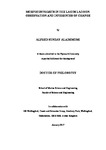MORPHODYNAMICS IN THE LAGOS LAGOON: OBSERVATION AND INFERENCES OF CHANGE
| dc.contributor.supervisor | Abbott, Victor James | |
| dc.contributor.author | Alademomi, Alfred Sunday | |
| dc.contributor.other | School of Biological and Marine Sciences | en_US |
| dc.date.accessioned | 2017-07-03T13:52:33Z | |
| dc.date.issued | 2017 | |
| dc.identifier | 10271984 | en_US |
| dc.identifier.uri | http://hdl.handle.net/10026.1/9585 | |
| dc.description.abstract |
The focus of this research is the study of lagoon ecosystem interaction and adjustment of the lagoon floor morphologies, water dynamics and sequences of change involving the motion of sediment. The aim of the study is to implement a functional mechanism to evaluate and analyse changes in the Lagos Lagoon and its ecosystem, with the objectives: (i) to investigate the extent and impact of urban expansion on the Lagoon coastline and its ecosystem; (ii) to quantify changes in the spatial extent of mangroves by use of satellite images from 1984 to 2016; (iii) to investigate the spatial dynamics of the Lagoon water floor and estimate its flushing time, (iv) to investigate the behaviour and relationship pattern of the Lagoon hydrodynamic parameters;, (v) to collect sediment samples from the Lagoon, analyse their settling behaviour and particle size distribution (PSD) in order to study their spatial evolution and characterisation; and (vi) to initiate a model that can predict the influence of sea level rise on the Lagoon ecosystem. The existing problem of an overcrowded human population in Lagos, the incessant repository of industrial effluence into its Lagoon, and increased flooding from the immediate watershed generate the research questions for this thesis. Lack of studies in the areas of morphodynamics and hydrodynamics on the Lagoon is a gap in the body of coastal knowledge, especially the temporal and long term dynamics of a significant Lagoon like that of Lagos. Understanding the dynamics of the Lagoon will enhance efficient monitoring, sustainable management and hence reveal the great importance the Lagoon preserves for the coastal region. Landsat images (1984 – 2016) of the study area (Lagos Lagoon) and its ecosystem were obtained for some specific data derivations. Land Surface Temperature (LST), NDVI and delineated Lagoon coastline were derived from the images. An Environment for Visualizing Images (ENVI) and a Geographic Information System (GIS) were used to extract land classification information, likewise, the GIS was used to develop a model for investigating the Lagoon coastline changes. With the use of ENVI and GIS software, land classification types were derived with the percentage of the coverage area for each land use classification for the years of study. A novel empirical method was designed to collect in-situ hydrodynamic data for both the dry and wet seasons in 2014, this was correlated and analysed using a case study approach. Also, in-situ bathymetric data was collected in 2014 to join the 2008 available data for studying the changes in the Lagoon water bed morphology. Functional models were used to examine the interaction of the various hydrodynamic information that was studied on the Lagoon. Results and inferences from the study show that the wetland of the system is depleting rapidly with increase urbanisation. In both lateral and vertical directions, the morphological shape of the Lagoon is reducing both in size and depth. The result from the model that investigated the system coastline indicates that reclamation and recession are taking place on the Lagoon coast at an approximate ratio of 4 to 1 whereas, the total surface area has reduced to approximately 204.51km2 as opposed to its approximate area of 208km2 as at the year 2010. The results from the analysis of the Lagoon salinity implies a wide salinity variation between the dry and the wet season; this confirms the system as brackish water in the dry season and freshwater in the wet season. Other inferences reveal the critical point of well-mixed water mass, significant vertical mixing during the wet season and a stable state during the dry season. In overview, the ratio of the Lagoon stratification during the dry season to that of the wet season is approximately 1 to 7 and flushing time of approximately 26 days and 22 days respectively. Lastly, the Lagoon possesses a varying settling velocity that is uniquely related to the diameter of its particles at various spatial locations. This research has been able to provide baseline investigations concerning the morphology and hydrodynamic study of the Lagos Lagoon. | en_US |
| dc.description.sponsorship | Federal Government of Nigeria through Tertiary Education Fund Trust (TETFund) | en_US |
| dc.description.sponsorship | Surveyors Council Of Nigeria (SURCON) | en_US |
| dc.language.iso | en | |
| dc.publisher | University of Plymouth | |
| dc.rights | Attribution-NonCommercial-NoDerivs 3.0 United States | * |
| dc.rights.uri | http://creativecommons.org/licenses/by-nc-nd/3.0/us/ | * |
| dc.subject | Inferred Hydrodynamics of Lagos Lagoon | en_US |
| dc.subject.classification | PhD | en_US |
| dc.title | MORPHODYNAMICS IN THE LAGOS LAGOON: OBSERVATION AND INFERENCES OF CHANGE | en_US |
| dc.type | Thesis | |
| plymouth.version | publishable | en_US |
| dc.identifier.doi | http://dx.doi.org/10.24382/456 | |
| dc.rights.embargodate | 2018-07-03T13:52:33Z | |
| dc.rights.embargoperiod | 12 months | en_US |
| dc.type.qualification | Doctorate | en_US |
| rioxxterms.version | NA | |
| plymouth.orcid_id | 0000-0001-5883-8672 | en_US |
Files in this item
This item appears in the following Collection(s)
-
01 Research Theses Main Collection
Research Theses Main



